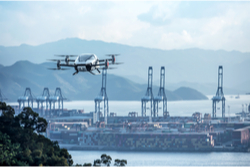 Welcome to November’s digest of sustainability news for BSI members. This November, as all eyes are on COP 27, we’re catching up on key developments in the world of sustainability, with breaking news, data and analysis drawn from across the globe. Like chillies in space, a flying car, pollution-eating moss, and kids’ clothes that grow as they do.
Welcome to November’s digest of sustainability news for BSI members. This November, as all eyes are on COP 27, we’re catching up on key developments in the world of sustainability, with breaking news, data and analysis drawn from across the globe. Like chillies in space, a flying car, pollution-eating moss, and kids’ clothes that grow as they do.
Rooftop bladeless wind turbines bring power to the neighbourhood
This small, sleek wind turbine generates power from winds as low as five miles per hour. And it takes up a fraction of the footprint of traditional wind farms whilst producing the same amount of power as 16 solar panels. Created by Aeromine Technologies, when these turbines combined with solar, a building could run completely on renewable energy.
Read more
Harvesting chillies in space is hot tip for adapting to climate change on earth
It’s one of the longest and most challenging plant experiments aboard the orbiting space station. Growing chillies 250 miles above earth was originally designed to supplement the astronauts’ packaged food-infused diet. But it’s also offering lessons in growing food with limited water and electricity input as droughts become more frequent.
Read more
UK power plant gets an injection of hydrogen in first for UK
Centrica Business Solutions is set to start injecting hydrogen into its existing gas peaking plant at Brigg, Lincolnshire as part of a UK first trial aimed at better understanding the role of hydrogen in power production. It’s the first time that hydrogen has been used within a grid-connected gas-fired power plant in UK.
Read more
Is it a bird? Is it a plane? No, it’s an electric car.
Electric cars are everywhere, and now electric flying cars are on the way. China’s XPENG X2 completed a short public flight recently in Dubai. Their zero-emission vehicle is a two-seater that uses vertical lift-off and landing to go from road to air. Suitable for low-altitude , short distance city flights, medical transportation and sightseeing are two promising uses.
Read more
Strengthening concrete with used PPE
The COVID-19 pandemic generated at least eight million tons of pandemic-associated plastic waste by 2021, including plenty of PPE. Engineers at RMIT University in Australia have developed a method to add personal protective equipment (PPE) waste to concrete. They found it can increase the material’s strength by up to 22 per cent while improving resistance to cracking.
Read more
The shower that recycles its own water
Drought is a growing problem in many parts of world, so a shower unit that reduces water waste is a refreshing idea. With this one, users switch to the recycling mode after washing, and the system cleans and reheats the water before sending it back through the pipes. A 10-minute shower uses up to 75% less water and cuts energy use by up to 66%. A household of four’s spend could drop by up to £1,118 per year.
Read more
Moss ‘walls’ that clean and cool the city air
Moss is very clever. It can filter the air by attracting tiny dust particles to its fine, dense leaves. And it biodegrades, stores, and eats airborne particles such as soot, ammonium salts, carbon dioxide, and pollen. As if that’s not enough, moss also absorbs warm air, then cools its surroundings as heat evaporates. Greencity Solutions has tested 16,000 species of moss for its moss wall biofilters.
Read more
Children’s clothes that grow as they do cut waste and carbon down to size
Winner of Amazon’s ‘Start-up of the Year’ award, material tech company Petit Pli’s pleated designs are all made from recycled plastic, and its children’s garments can ‘grow’ up to seven sizes as the child grows. Besides reducing waste and overproduction, the fewer numbers of items of clothing consumers buy each year means the bigger number of reductions in carbon dioxide emissions.
Read more
To discover more about how BSI is supporting businesses to meet the challenges of climate change and net zero, why not visit our standards, knowledge and best practice in sustainability page, here.

 Welcome to November’s digest of sustainability news for BSI members. This November, as all eyes are on COP 27, we’re catching up on key developments in the world of sustainability, with breaking news, data and analysis drawn from across the globe. Like chillies in space, a flying car, pollution-eating moss, and kids’ clothes that grow as they do.
Welcome to November’s digest of sustainability news for BSI members. This November, as all eyes are on COP 27, we’re catching up on key developments in the world of sustainability, with breaking news, data and analysis drawn from across the globe. Like chillies in space, a flying car, pollution-eating moss, and kids’ clothes that grow as they do.